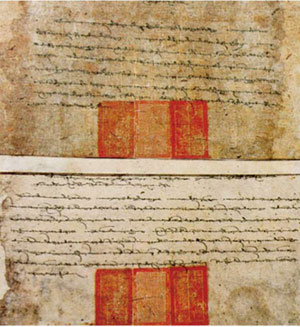The 14th Dalai Lama
The 14th Dalai Lama, Dainzin Gyamco, is a son of a farmer in Dangcai Village, near Taer Monastery, in west China's Qinghai Province. He was born on May 5, 1935 and was originally named Lhamo Toinzhub. Following the death of the 13th Dalai Lama on Dec, 17,1933, Tibet's Gaxag Government and three monasteries in Lhasa (Sera Monastery, Ganden Monastery and Drepung Monastery) started searching for the reincarnated soul boy in accordance with religious practices.
Three candidates for the soul boy were found. In accordance with the 29-Article Imperially Approved Ordinance for the More Efficient Governing of Tibet by the Qing dynasty, the soul boy must be approved by the Qing Government. Moreover, the regulations stipulate that if there are several candidates, the soul boy shall be decided by drawing a lot from a gold urn. At the lot-drawing ceremony, the lots bearing the names of candidates in Chinese, Mandarin and Tibetan languages are put into a gold urn and drawn by the Grand Minister Resident of Tibet of Qing dynasty in the face of the representatives of Tibetan monks and lay people.
|

|
|
The picture shows the 29-Article Imperially Approved Ordinance for the More Efficient Governing of Tibet. (Xinhua file Photo)
|
If the candidate with the lot bearing his name has the lucky number, he shall be the reincarnated soul boy of the dead Dalai or Panchen. The result of the lot drawing shall be reported to the emperor or the central government of the Qing dynasty for approval. Since there were three candidates for the soul boy of the 13th Dalai, a lot-drawing process was essential. In the winter of 1938, Living Buddha Prince Regent Razheng of the Tibetan government reported to Wu Zhongxin, commissioner of the Chinese Commission for Mongolian and Tibetan Affairs of the Nationalist Government, that Lhamo Toinzhub, the reincarnated soul boy of the 13th Dalai, had been found in Qinghai Province. The Nationalist Government then instructed Ma Bufang, chairman of the Qinghai provincial government, to send troops to escort the soul boy to Tibet and also allocated 100,000 silver dollars as travel expenses.
|

|
|
In this file photo, monks and officials of the local government of Tibet host a grand ceremony to welcome Wu Zhongxin, commissioner of the Chinese Commission for Mongolian and Tibetan Affairs of the Nationalist Government, in Drepung Monastery in Lhasa. Wu arrived in Lhasa on Jan. 15, 1939, to preside over the ceremony of the 14th Dalai Lama's title-giving and enthronement. (Xinhua file Photo)
|
Lhamo Toinzhub and his entourage left Xining, the capital of Qinghai Province, in July, 1939 and arrived in Lhasa in October. The Gaxag government reported Chiang Kai-shek, chairman of the Nationalist Government, saying "the title-granting, ordainment and a sitting-in-bed ceremony (enthronement ceremony) for the soul boy shall be held on an auspicious day and the date shall be submitted to the government soon."
Later, Prince Regent Razheng of the local Tibetan government reported to the Central Government that as Lhamo Toinzhub, the soul boy from Qinghai Province, was exceptionally "intelligent." He proposed that the soul boy should be exempt from the lot-drawing procedure. On Jan. 26, 1940, Razheng wrote to Wu, saying that "All Tibetan monks and lay people, old and young, rich and poor, all sincerely believe (Lhamo Toinzhub) is the reincarnation of the 13th Dalai. As all hold the same opinion, a lot-drawing process is unnecessary and the ordainment ceremony can be held as stipulated. All this has been reported to the Central Government for approval."
Wu cabled the Executive Yuan of the Nationalist Government the following day after he received the letter. Chiang, then chairman of the Executive Yuan, reported to the Nationalist Government on 31, Jan, asking for permission that the lot-drawing be exempted and allow Lhamo Toinzhub be enthroned as the 14th Dalai Lama. Chiang also asked for fund for the sitting-in-bed ceremony. On Feb. 3, Lin Sen, chairman of the Nationalist Government, issued an order on behalf of the Nationalist Government, which reads:
"Order from the Nationalist Government: the Qinghai soul boy Lhamo Toinzhub, with unusual wisdom and extraordinarily intelligent signs, has been found as the reincarnation of the 13th Dalai Lama and should be allowed to ascend his throne as the 14the Dalai Lama without going through the lot-drawing ceremony. "
On Feb. 22, 1940, in accordance with historical regulations and the requirement of the local Tibetan government, the Nationalist Government dispatched Wu Zhongxin, commissioner of the Chinese Commission for Mongolian and Tibetan Affairs, to Tibet for the sitting-in-bed ceremony. Wu visited the soul boy on behalf of the Central Government and then presided over the enthronement ceremony.